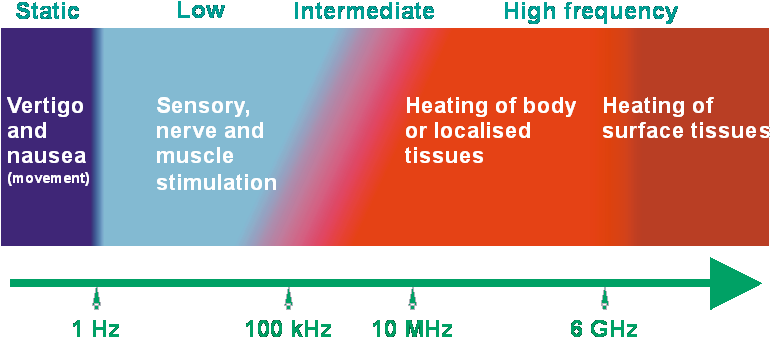The type of effect that electromagnetic fields have in people depends primarily on the frequency and intensity: other factors such as the shape of the waveform may also be important in some situations. Some fields cause stimulation of sensory organs, nerves and muscle, while others cause heating. The effects caused by heating are termed thermal effects in the Control of EMF at Work Regulations 2016, while all other effects are termed non-thermal effects. Further details about health effects of exposure to electromagnetic fields can be found in Appendix B of the Non-binding guide to good practice for implementing Directive 2013/35/EU Electromagnetic Fields.
Importantly, all these effects show a threshold below which there is no risk, and exposures below the threshold are not cumulative in any way. The effects caused by exposure are transient being limited to the duration of exposure, and they will stop or decrease once exposure ceases. This means that there can be no further risk to health once exposure has ended.
Direct effects
Direct effects are changes that occur in a person as a result of being exposed to an electromagnetic field. The regulations only consider well-understood effects that are based on known mechanisms. They distinguish between sensory effects and health effects, which are considered to be more serious.
The direct effects are:
- effects on sense organs, nerves and muscles from low frequency fields (up to 100 kHz)
- heating of the whole body or parts of it from high frequency fields (10 MHz and above); above a few GHz heating is increasingly limited to the surface of the body
- effects on nerves, muscles and heating from intermediate frequencies (100 kHz – 10 MHz)
These concepts are illustrated in Figure 1.
Long-term effects
The regulations do not address suggested long-term effects of exposure to electromagnetic fields, since there is currently no well-established scientific evidence of a causal relationship.
Indirect effects
Undesirable effects may occur due to the presence of objects in the field resulting in a safety or health hazard. Contact with a live conductor is not within the scope of the regulations.
The indirect effects are:
- interference with medical electronic equipment and other devices
- interference with active implanted medical devices or equipment, such as cardiac pacemakers or defibrillators
- interference with medical devices worn on the body, such as insulin pumps
- inductive heating of passive metallic implants (artificial joints, pins, wires or plates)
- perturbation of induced internal electric fields caused by the presence of passive metallic implants
- inductive heating of shrapnel, body piercings, tattoos and body art
- unintentional initiation of detonators
- fires or explosions from ignition of flammable or explosive material
- electric shocks or burns from contact currents when a person touches a conductive object in an electromagnetic field and one of them is grounded whilst the other is not
Appendix E of the Non-binding guide to good practice for implementing Directive 2013/35/EU Electromagnetic Fields provides further information about indirect effects and how these risks may be managed in the workplace.
Figure 1 Schematic representation of principal direct effects of EMF showing the main frequency breakpoints used for the definition of exposure limit values and action levels.

